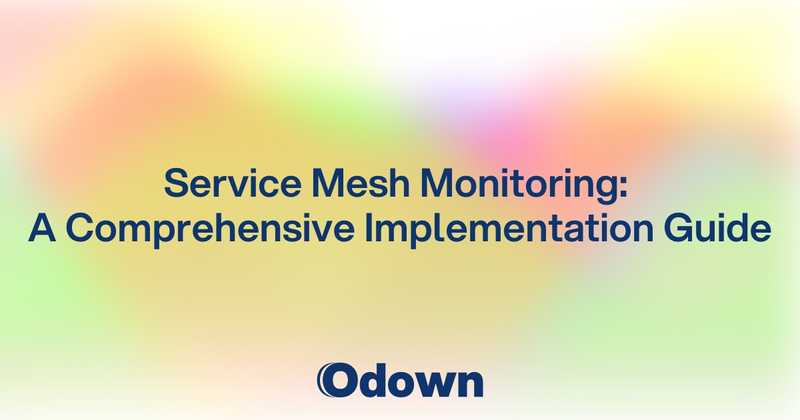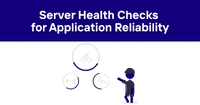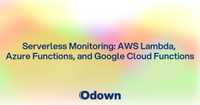Service Mesh Monitoring: A Comprehensive Implementation Guide
As organizations adopt microservices architectures, the need for effective service communication becomes increasingly critical. Service meshes have emerged as a powerful solution for managing this complexity, but they introduce their own monitoring challenges. Following our exploration of monitoring for French websites, this guide focuses on the specific requirements for monitoring service mesh implementations effectively.
A service mesh creates an abstraction layer that handles service-to-service communication, security, traffic management, and observability for microservices. While this abstraction simplifies many aspects of microservice management, it adds a new layer that must be monitored to ensure optimal performance.
This comprehensive guide explores the unique challenges of monitoring service mesh environments and provides practical implementation strategies for effective observability.
Monitoring Challenges in Service Mesh Architectures
Before implementing a monitoring solution, it's essential to understand the specific challenges presented by service mesh environments.
The Complexity of Modern Service Mesh Environments
Service mesh architectures introduce several layers of complexity:
Control Plane vs. Data Plane Distinction
Service meshes consist of two primary components, each requiring distinct monitoring approaches:
- Control Plane: The central management layer that configures policies, authentication rules, and traffic routing
- Data Plane: The proxy components (sidecars) deployed alongside each service that intercept and control traffic
This dual-layer architecture means monitoring must capture both:
- Health and performance of the control plane components
- Service-to-service communication mediated by the data plane
- Correlation between configuration changes and communication patterns
Multi-Dimensional Visibility Requirements
Service mesh monitoring requires visibility across multiple dimensions:
- Network-Level Metrics: Latency, throughput, error rates between services
- Service Health: Performance of individual services behind the mesh
- Proxy Performance: Resource usage and efficiency of the sidecar proxies
- Policy Enforcement: Effectiveness of security and routing policies
- Configuration Changes: Impact of mesh configuration adjustments
This multi-dimensional nature means traditional application or infrastructure monitoring approaches alone are insufficient.
Scale and Volume Challenges
The scale of service mesh environments presents significant monitoring challenges:
- High Cardinality Metrics: The number of service-to-service interactions creates extremely high cardinality
- Telemetry Volume: Service meshes generate enormous amounts of monitoring data
- Dynamic Environments: Services appear and disappear frequently in container environments
- Resource Overhead: Monitoring itself can impact performance if not carefully implemented
Organizations must balance comprehensive visibility with the practical limitations of telemetry collection and storage.
Golden Signals Monitoring for Microservices
While service meshes introduce new complexity, the fundamental "Golden Signals" remain a core framework for effective monitoring:
Latency: Service Response Time Tracking
In service mesh environments, latency monitoring is multi-faceted:
- End-to-End Request Latency: The total time for a request to traverse the entire service chain
- Service-Specific Latency: Time spent in each individual service
- Mesh Overhead: Additional latency introduced by the service mesh proxies
- P95/P99 Percentiles: Focus on tail latency, not just averages, to identify outliers
Effective latency monitoring requires:
- Baseline Establishment: Define normal latency ranges for each service-to-service interaction
- Request Categorization: Segment latency by request type, client service,
Retry
A
Continue
Edit
- Request Categorization: Segment latency by request type, client service, and other attributes
- Proxy vs. Application Time: Distinguish between time in the mesh proxy and in the application
- Context-Aware Thresholds: Different services have different performance characteristics and requirements
Traffic: Request Volume Monitoring
Traffic monitoring helps identify changes in service usage patterns:
- Request Rate by Service: Track requests per second for each service
- Traffic Distribution: Monitor how traffic is distributed across service instances
- Protocol-Specific Metrics: Track metrics specific to HTTP, gRPC, TCP, and other protocols
- Retry Traffic: Identify abnormal retry patterns that may indicate issues
For effective traffic monitoring:
- Service Mapping: Maintain an up-to-date service inventory and dependency map
- Traffic Trend Analysis: Identify gradual shifts in traffic patterns over time
- Capacity Planning: Use traffic metrics to inform scaling decisions
- Anomaly Detection: Establish normal traffic patterns and alert on deviations
Errors: Failure Detection and Analysis
Error monitoring in service mesh environments must account for multiple failure modes:
- HTTP Status Codes: Track non-2xx response codes between services
- Connection Failures: Identify network-level connection issues
- Timeouts: Detect request timeouts at various levels
- Circuit Breaking Events: Monitor when circuit breakers are triggered
- Authentication Failures: Track authorization and authentication errors
Key error monitoring strategies include:
- Error Categorization: Classify errors by type, source, and impact
- Error Rate Calculation: Monitor error percentage rather than absolute counts
- Correlation Analysis: Connect errors with configuration changes or deployments
- Business Impact Assessment: Prioritize errors based on impact to critical paths
Saturation: Resource Utilization Tracking
Saturation metrics help identify when services approach their resource limits:
- Proxy Resource Usage: CPU, memory, and connection utilization of sidecar proxies
- Backpressure Indicators: Queue depth and request buffering metrics
- Connection Pool Status: Utilization of connection pools between services
- Control Plane Resource Usage: Resource consumption of management components
For comprehensive saturation monitoring:
- Resource Quotas Correlation: Connect utilization metrics with defined resource limits
- Early Warning Thresholds: Set alerts below 100% utilization to provide response time
- Bottleneck Identification: Use saturation metrics to identify system constraints
- Horizontal vs. Vertical Scaling Decisions: Inform decisions about scaling approach
Service-to-Service Communication Tracking
Beyond the Golden Signals, service mesh environments require specific focus on communication patterns:
Request Tracing Across Services
Distributed tracing becomes critical in service mesh environments:
- Trace Context Propagation: Ensure trace IDs flow through all services
- Service Dependency Visualization: Map which services call which others
- Critical Path Analysis: Identify the slowest components in request chains
- Unusual Patterns Detection: Spot abnormal communication sequences
Effective implementation requires:
- Sampling Strategy: Determine appropriate sampling rates for different traffic types
- Trace Correlation: Connect traces with logs and metrics for complete visibility
- Span Tagging: Add relevant business and technical context to spans
- Service Boundary Identification: Clearly mark where requests cross service boundaries
Service Dependency Mapping
Understanding service relationships is essential for troubleshooting and capacity planning:
- Real-Time Dependency Graphs: Visualize current service communication patterns
- Historical Dependency Changes: Track how service relationships evolve over time
- Critical Service Identification: Highlight services that are dependencies for many others
- Orphaned Service Detection: Identify services no longer receiving traffic
Key implementation considerations include:
- Automated Discovery: Dynamically update service maps as new services are deployed
- Versioned Dependencies: Track communication between specific service versions
- Traffic Volume Visualization: Show not just connections but volume of requests
- Failure Impact Projection: Predict the impact of service failures on other components
Protocol-Specific Monitoring
Service meshes support multiple communication protocols, each requiring specific monitoring:
- HTTP/HTTPS Metrics: Status codes, method distribution, URL patterns
- gRPC Metrics: Method calls, status codes, streaming indicators
- TCP Metrics: Connection establishment, duration, bytes transferred
- WebSocket Metrics: Connection lifecycle, message frequency, stream health
For comprehensive protocol monitoring:
- Protocol Detection: Automatically identify and classify traffic by protocol
- Protocol-Appropriate Baselines: Establish normal patterns for each protocol
- Content Awareness: Monitor payload sizes and types where appropriate
- Protocol Errors Analysis: Decode and categorize protocol-specific errors
Implementing Effective Observability for Istio, Linkerd, and Consul
With an understanding of the general challenges, let's examine how to implement monitoring for popular service mesh solutions.
Istio Monitoring Implementation
Istio is one of the most powerful and complex service mesh implementations, requiring a comprehensive monitoring approach:
Istio Telemetry Architecture
Istio provides built-in telemetry capabilities that must be properly configured:
- Mixer Legacy vs. Telemetry V2: Understand the evolution of Istio's telemetry systems
- Prometheus Integration: Istio exposes metrics that Prometheus can scrape
- Envoy Statistics: The underlying Envoy proxies generate detailed metrics
- Standard vs. Custom Metrics: Istio provides default metrics and allows custom metric definition
For effective implementation:
- Configuration Verification: Ensure telemetry components are correctly deployed
- Scraping Endpoint Security: Properly secure metrics endpoints while enabling collection
- Performance Tuning: Adjust metric collection frequency and cardinality for efficiency
- Storage Planning: Size Prometheus or other storage based on metric volume
Key Metrics for Istio Monitoring
Focus on these essential metrics for comprehensive Istio visibility:
- istio_requests_total: Count of requests by source, destination, response code, etc.
- istio_request_duration_milliseconds: Request latency distributions
- istio_tcp_connections_opened_total: TCP connection tracking
- istio_tcp_received_bytes_total: Network throughput monitoring
- istio_tcp_sent_bytes_total: Egress traffic volume
Custom dashboards should include:
- Service-Level Overviews: High-level health by service
- Namespace Dashboards: Grouped metrics by Kubernetes namespace
- Mesh-Wide Health: Overall service mesh performance
- Control Plane Status: Health of Istio components (istiod, etc.)
Istio Control Plane Monitoring
The Istio control plane requires specific attention:
- istiod Health: Monitor the central control plane component
- Configuration Distribution Metrics: Track how configurations propagate to proxies
- Validation Webhook Performance: Monitor admission controller performance
- Sidecar Injection Metrics: Track successful and failed sidecar injections
Implementation considerations include:
- Control Plane Redundancy: Monitor multiple istiod instances if deployed for high availability
- Version Skew Detection: Identify version mismatches between control and data planes
- Configuration Impact Analysis: Connect configuration changes to data plane behavior
- Resource Usage Tracking: Monitor control plane CPU and memory consumption
Linkerd Monitoring Setup
Linkerd provides a lighter-weight service mesh with built-in monitoring capabilities:
Linkerd's Prometheus and Grafana Integration
Linkerd includes monitoring components that must be properly configured:
- On-Cluster Monitoring: Linkerd deploys its own Prometheus and Grafana instances
- Metrics Exposure: Understand how Linkerd's proxies expose metrics
- Dashboard Customization: Extend the default Linkerd dashboards for your needs
- Metrics Federation: Integrate Linkerd's metrics with existing monitoring infrastructure
For effective setup:
- Resource Allocation: Ensure monitoring components have adequate resources
- Retention Configuration: Adjust metric retention based on requirements
- Access Control: Configure proper access to monitoring interfaces
- Alerting Integration: Connect Linkerd's Prometheus to alerting systems



